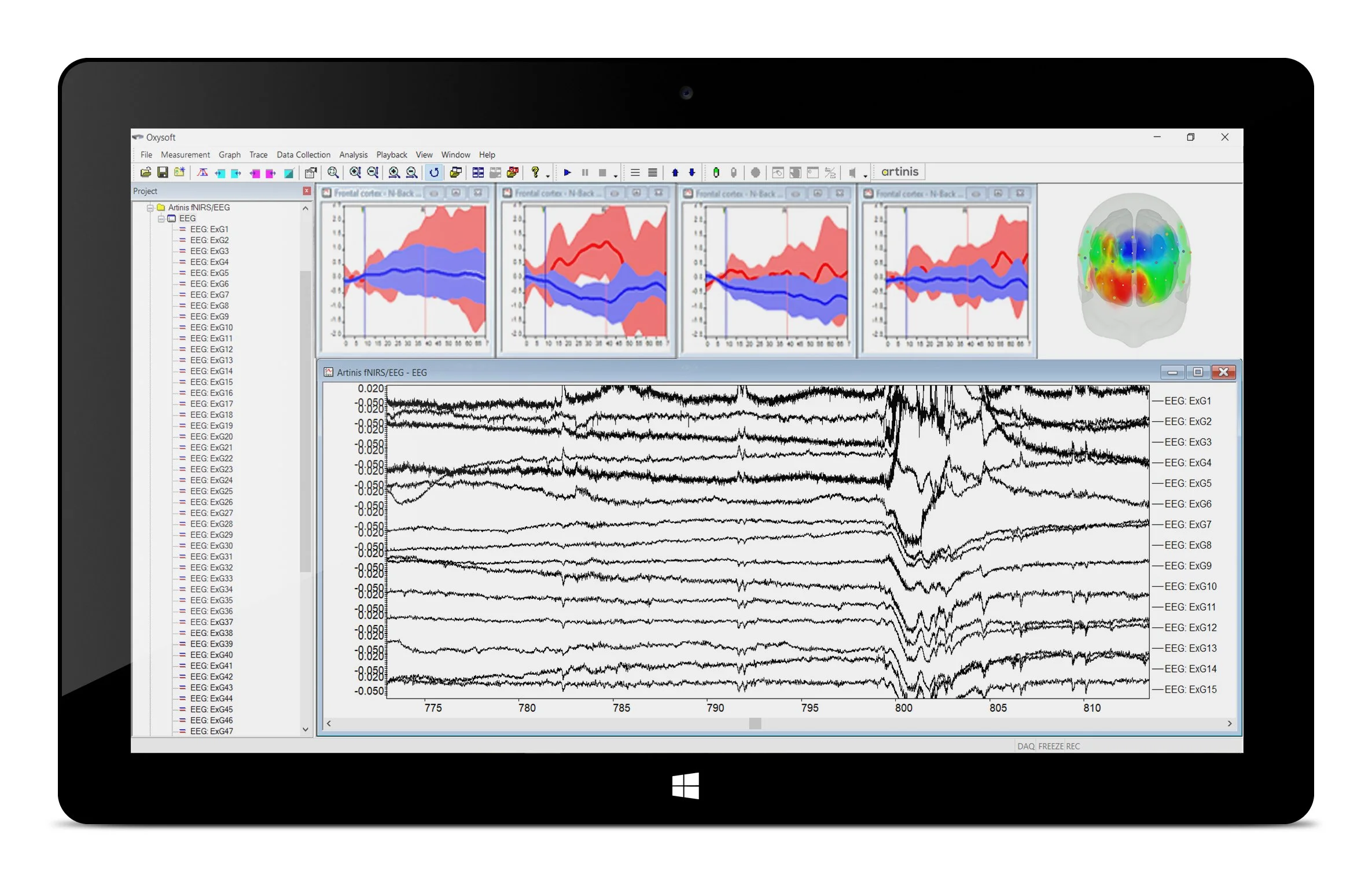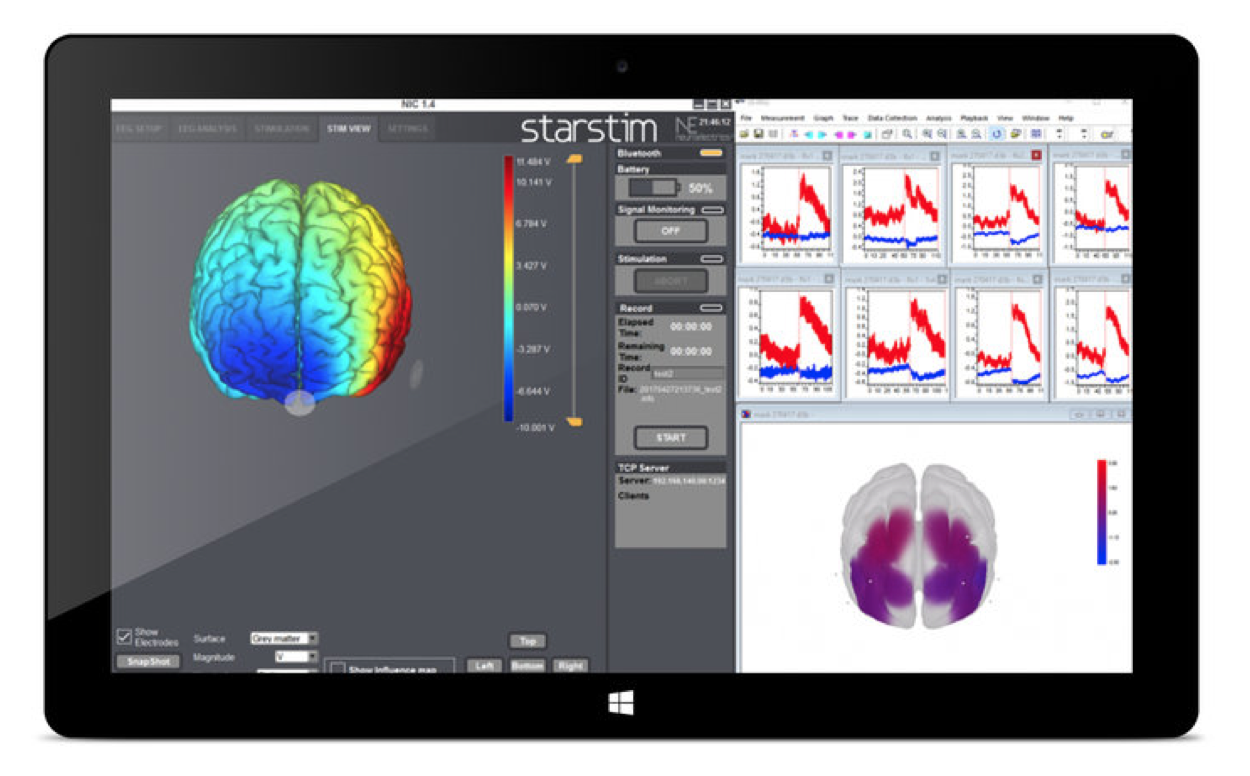Combining the world of NIRS and EEG
EEG and fNIRS are complementary measuring techniques. EEG measures electrophysiological brain activation, that is the electromagnetic field created when neurons in the brain are firing. fNIRS measures the hemodynamic response, that is the change of oxygen in the blood when a brain region becomes active. By combining EEG and fNIRS, a more complete picture of brain activity is obtained: activation of neurons and energy demand of neurons.
In this blog, we will not focus on why you should combine near-infrared spectroscopy (NIRS) with electroencephalography (EEG), but on how we at Artinis manage to seamlessly integrate these technologies into our product portfolio. We do not only offer the option to use these technologies simultaneously (in a way more companies are doing, just by adding some extra holes in their headgear), but how we extend the possibilities of brain monitoring with those technologies by integrating both techniques in hardware and software. To take integration a step further: a truly combined system.
There are multiple ways to monitor brain activity, e.g. Functional Magnetic Resonance Imaging (fMRI), EEG and NIRS. Already a long time ago, Artinis combined NIRS and MRI with the OxyMon System. The next step we undertook in the process of combining multiple brain monitoring techniques was to combine the widely used EEG technology. There were a few challenges that we solved e.g. EEG uses the 10-20 system positions to place the electrodes. These positions could overlap with the positions of the NIRS optodes [1,2]. So instead of positioning these electrodes and optodes next to each other or sacrificing one or the other, we wanted to use the same spot.
With our partner TMSi, we developed a brand new electrode and electrode/optode holder to be able to use both sensors together at the same location. This electrode (Figure 1, left panel) is very small and is positioned close to the NIRS optode. The conductive EEG gel will evenly spread around the NIRS optode. This principle is visualized in the right panel of Figure 1. The position we place the electrode overlaps the NIRS optode. This principle makes the measurement convenient because the user does not need to sacrifice one cap position for the other.
“This principle makes the measurement convenient because the user does not need to sacrifice one cap position for the other.”
Figure 1: Combined NIRS-EEG holder (http://www.artinis.com/nirs-eeg-package/). Left: isometric top view of the EEG electrode and the NIRS optode. Right: the isometric bottom view of the EEG electrode, NIRS optode and EEG gel.
We wanted our customers to feel comfortable with the tools he or she is familiar with. To do so, we extended our portfolio of EEG holders, so that the user was able to combine our NIRS system with their EEG system. We started with a ‘ring electrode holder’ that fits our headcap/headband gear and continued with the ‘active electrode holder’ for the Biosemi™ active electrodes. We developed the EEG integration in such a way that it is compatible with the Oxymon system, the Brite System, and the Octamon System.
In order to offer a more complete user experience, we also redesigned Oxysoft, our recording and analysis software, to record EEG data synchronized with our NIRS equipment. The NIRS-EEG software package, a combination of both modalities in one software suite allows you (depending on what you choose to use) to simultaneously measure EEG and NIRS in the same software, and store the resulting data in one synchronized file. Other EEG systems can be integrated using a lab streaming layer interface, which will also result in a combined NIRS-EEG data file. Figure 2. Shows how we incorporated the EEG data in Oxysoft.
Figure 2. The NIRS-EEG software package, an Oxysoft extension to record EEG-data synchronized with NIRS data.
In a parallel project, we joined forces with NeuroElectrics and Silverline Research Services to present the Starstim fNIRS, a wearable solution for brain stimulation and imaging. It combines tCS (tDCS, tACS, tRNS[3, 4 and 5]), EEG and fNIRS in one single headcap. It allows clinicians and researchers to measure resting-state and task-related cortical activity and/or hemodynamics before, during and after transcranial electrical stimulation in real-world settings. The single-packaged Starstim fNIRS will contain superior support from Silverline Research Services by dr. Mark Muthalib.
Figure 3: Oxysoft and NIC (Neuroelectrics Instrument Controller) software package.
In this blog post, we have described our current solutions to combine the worlds of NIRS and EEG. We have shown the unique small electrode, the combined NIRS-EEG holder, the ring electrode holder, and the Biosemi active holder. Our NIRS-EEG software package and the wearable solution for brain stimulation and image: Startsim fNIRS. We sincerely believe that a combination of brain imaging technologies will give our users the awesome opportunity to take brain imaging to the next level. Here at Artinis, it is our goal to make optical imaging easy.
Glossary:
[1] NIRS optodes laserbased system (OxyMon): fiber optics connected to the system to send or detect infrared lights
[2] NIRS optodes LED system: Infra RED LED (Transmitters/ Tx) and diode detectors (Receivers/ Rx)
[3] tDCS: transcranial direct-current stimulation (https://www.neuroelectrics.com/software/)
[4] tACS: transcranial alternating current stimulation (https://www.neuroelectrics.com/software/)
[5] tRNS: transcranial random noise stimulation (https://www.neuroelectrics.com/software/)


